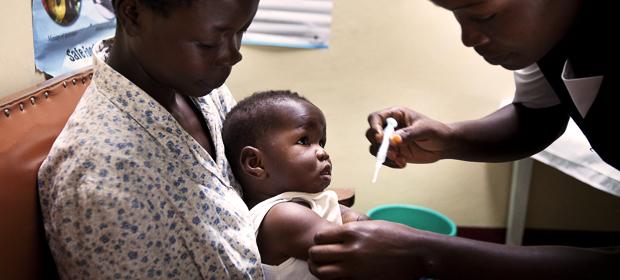Where We Work
See our interactive map


When it comes to talking to clients about vaccinations, clear communication is essential for health workers.
You can’t swing a subcutaneous injection syringe in the US right now without hitting a headline related to vaccines, or to the ongoing outbreaks they could have prevented.
Take measles, for instance. It was eliminated in the US in 2000, but the viral infection made a disheartening comeback in 2014 with a record 644 cases. Now 2015 is shaping up much the same—reports from the US Centers for Disease Control and Prevention show 102 new cases in January alone.
An outbreak of the mumps is making its way through the North America's National Hockey League, of all populations, leaving some the toughest athletes in the world prostrate and quarantined.
When vaccines are not well understood, dangers abound.
And even after decades of work to eradicate it, the world is still grappling with polio—a contagious, incurable, crippling, highly preventable disease. There were 350 cases in eight countries last year. If we look closely, we can almost see the thread that ties many of these outbreaks to their source: misinformation.
When vaccines are not well understood, dangers abound. For example, alarming rumors and distrust of the West have made polio immunization a perilous job for health workers in Nigeria and Pakistan. Over 100 have been murdered since 2007.
And Western countries aren’t immune to destructive rumors. The myth that vaccines cause autism, which began with a now-discredited scientific publication in 1998, has led many American and European parents to balk at vaccinations for their children. Even now, years after that study was debunked, the damage persists. A small but vocal anti-vaccine movement in the US has led many to eschew the life-saving benefits of vaccines. Hence the measles at Disneyland and the mumps in the locker room.
It Takes a Health Worker to Administer a Vaccine
Standing in the space between misinformation and a parent’s decisions about vaccination are health workers. They’re the ones who administer vaccines. They’re the ones who bridge the gap between scientific knowledge and how a community benefits from it.
And, because they’re so often there during that crucial moment when a parent decides whether a child will be vaccinated, they’re the ones who have to be ready to talk about the process and advantages of vaccination clearly, concisely, and effectively.
For health workers, communication skills are key. And so is training.
Take, for example, Almaz, a nursing student at Alkan University of Ethiopia. During her apprenticeship, she was tasked with administering a vaccine to a child. But the child’s mother was reluctant. Why was this necessary? Would it hurt her child?
For health workers, communication skills are key. And so is training.
Almaz explained to the mother that nothing bad would happen, and described how the benefits far outweighed any risk. One crucial moment later, the mother understood. And the child was vaccinated.
This was just a brief encounter during Almaz’s training, but it left an impression on her. She had the ability to quell her clients’ fears, she found, and make a difference in the health of her community.
Vaccinations are a vital part of family health in Ethiopia—after all, it sits at the buckle-end of sub-Saharan Africa’s meningitis belt. But, as headlines everywhere are now reflecting, it’s a vital part of public health everywhere else, too.
IntraHealth International stands firm in its support for life-saving vaccines—and for the people who provide them. Want to help train more nursing students like Almaz in Ethiopia? You can donate here.
Get the latest updates from the blog and eNews




